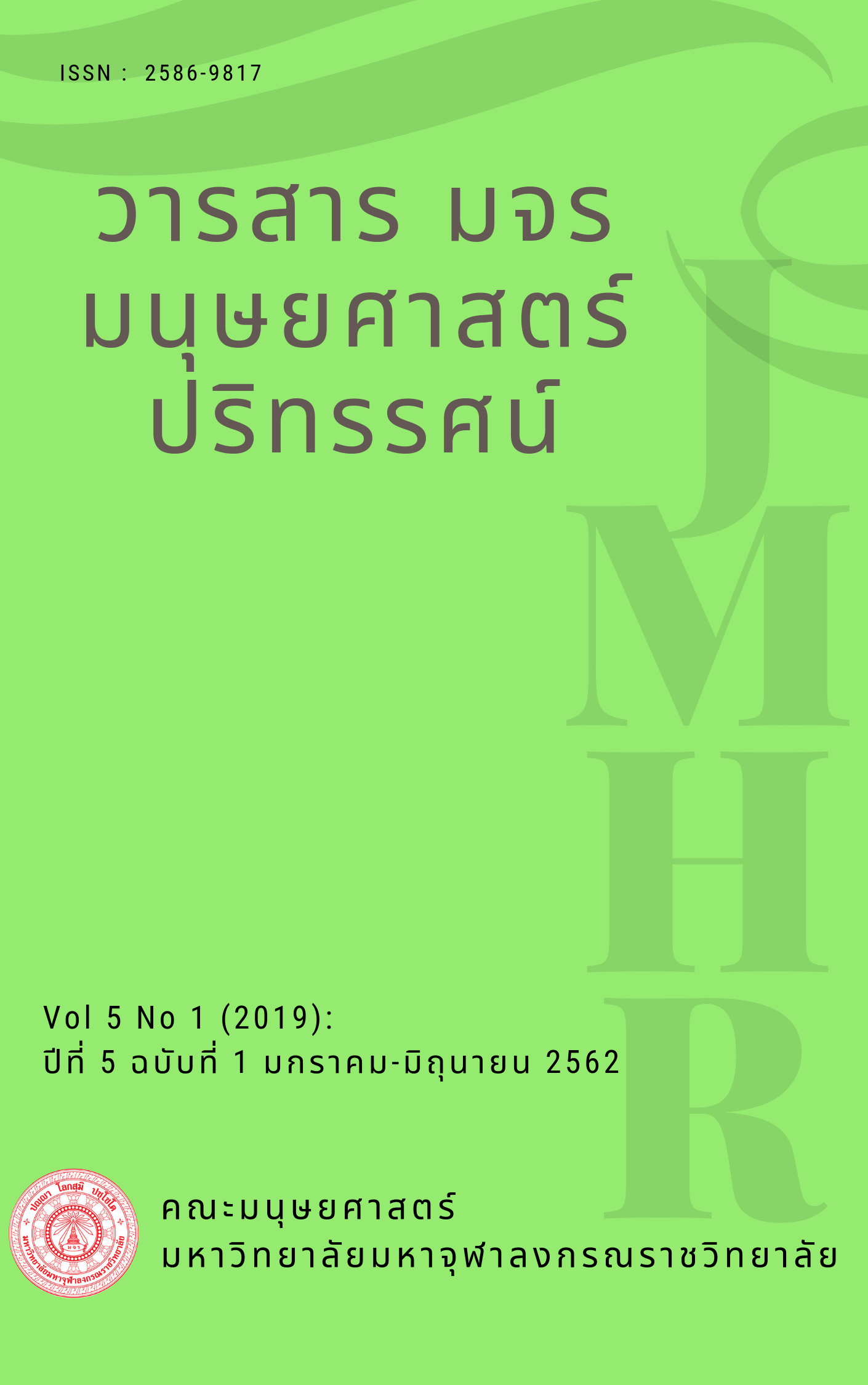พื้นที่การท่องเที่ยวในวัดพุทธศาสนา:วัดร่องขุ่นและวัดห้วยปลากั้ง
คำสำคัญ:
วัดร่องขุ่น, วัดห้วยปลากั้ง, พื้นที่ท่องเที่ยวในวัดพุทธศาสนา.บทคัดย่อ
บทคัดย่อ
บทความเรื่อง พื้นที่การท่องเที่ยวในวัดพุทธศาสนา:วัดร่องขุ่นและวัดห้วยปลากั้ง มีวัตถุประสงค์ เพื่อเสนอบริบทและการจัดพื้นที่การท่องเที่ยวในวัดร่องขุ่นและวัดห้วยปลากั้ง วัดร่องขุ่นเป็นวัดเก่าแก่ของหมู่บ้านร่องขุ่น ห่างจากตัวเมืองเชียงรายไปทางทิศใต้ 13 กิโลเมตร พ.ศ. 2540 อาจารย์เฉลิมชัย โฆษิตพิพัฒน์ เป็นบุคคลในหมู่บ้าน เป็นศิลปินที่มีชื่อเสียง มีอุดมการณ์ในการสร้างวัดร่องขุ่น 3 ประการ คือสร้างเป็นพุทธบูชา เป็นสมบัติของชาติและให้เป็นศิลปะประจำรัชกาลที่ 9 วัดห้วยปลากั้ง เป็นวัดร้างมานาน พื้นที่เป็นเนินดอย ห่างจากตัวเมืองไปทางทิศตะวันตกเฉียงเหนือ 15 กิโลเมตร ในพ.ศ. 2548 พระอาจารย์พบโชค ติสฺสวํโส เริ่มก่อสร้าง มีอุดมการณ์เพื่อให้เป็นศูนย์รวมจิตใจของชาวพุทธ เป็นวัดที่มีแนวคิดแบบพุทธศาสนาฝ่ายมหายาน
พื้นที่ท่องเที่ยวในวัด วัดร่องขุ่นมี 5 แห่ง วัดห้วยปลากั้งมี 2 แห่ง วัดทั้งสองแห่งใช้การจัดพื้นที่ด้วยหลักสัปปายะ 7 ทั้งเหมือนกันและแตกต่างกัน วัดร่องขุ่นสร้างด้วยการนำของฆราวาส วัดห้วยปลากั้งสร้างด้วยการนำของพระ ทั้งสองวัดมีความรู้สึกในการท่องเที่ยวแตกต่างกัน วัดห้วยปลากั้งมีบรรยากาศของวัดมากกว่าวัดร่องขุ่น แต่อย่างไรก็ตามทั้งสองวัดเป็นแหล่งท่องเที่ยวในวัดพระพุทธศาสนาที่ได้รับความนิยมอย่างสูงในจังหวัดเชียงราย
เอกสารอ้างอิง
การท่องเที่ยวแห่งประเทศไทย, “เชียงราย แต้ แต้”, ไทยโพสต์ (13 พฤษภาคม 2561), น.พิเศษ.
พระพรหมคุณาภรณ์ (ป.อ. ปยุตฺโต). พจนานุกรรมพุทธศาสตร์ ฉบับประมวลศัพท์. พิมพ์ครั้งที่ 19. กรุงเทพฯ:
โรงพิมพ์พระพุทธศาสนาของธรรมสภา, 2556.
มัลลิกา ภูมะธนและคณะ. แนวคิดการจัดการท่องเที่ยว (วัด) ในพระพุทธศาสนา:หลักการและวิถีปฏิบัติ.
วารสารมจร.มนุษยศาสตร์ปริทัศน์. (ปีที่ 2 ฉบับที่ 2 กรกฎาคม – ธันวาคม, 2559), หน้า 43.
สุดแดน วิสุทธิลักษณ์. องค์ความรู้ว่าด้วยการท่องเที่ยวเชิงสร้างสรรค์:คู่มือและแนวทางปกฺบัติ,
คณะสังคมวิทยามานุษยวิทยา มหาวิทยาลัยธรรมศษสตร์, 2558.
10 ประเทศเป็นมิตรที่สุดในโลกจากการโหวตของนักเดินทาง (ออนไลน์) แหล่งที่มา
https://www.tieweng.com/top-friendliest-people-in-the-world/ (8 ธ.ค. 2561).
การสร้างวัดร่องขุ่น (ออนไลน์) แหล่งที่มา https://www.วัดร่องขุ่น.com (8 ธ.ค. 2561).
Jesper Kunde. อยากดังต้องโดดเด่น. แปลโดย ดนัย จันทร์เจ้าฉาย. พิมพ์ครั้งที่ 5. กรุงเทพฯ: เพียร์สัน เอ็นดูเคชั่น
อินโดไชน่า 2547.






